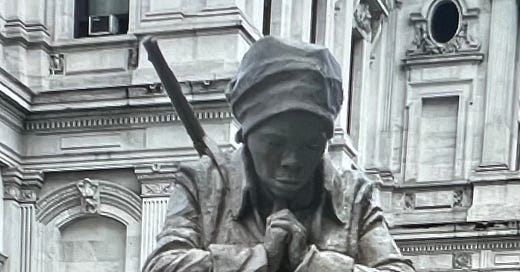The New York Times reports that the city of Philadelphia invited white artist Wesley Wofford to design Harriet Tubman's statue.
After complaints the city held a call for more submissions. They received fifty applications and named five semifinalists—all of whom are black. Wofford was rejected.
Both Wofford and black sculptor Alvin Pettit have each created brilliant evocations of Harriet’s spirit, but Wofford is excluded because of his race.
Personally, Pettit’s statue strikes me as the more intense embodiment of Tubman’s radical Christianity. Wofford’s is a very close second; and yes, beauty is in the eye of the beholder.
This writer grew up near Miss Tubman’s residence at Auburn, New York, and resided in Auburn for two years. I feel as closely identified with her as anyone. She is the quintessential Christian in the rare situation of an armed combat (freeing slaves) that actually was righteous.
Some observers will minimize this controversy as a “footnote of history.” By that evasion any detail of the past can be marginalized. The history of the city of Auburn is fascinating. In addition to Tubman’s fugitive slave redoubt, there is the William Seward mansion—the residence of Lincoln’s Secretary of State who, in his early career, led the movement in New York against secret societies and in particular, Freemasonry. Auburn is also home to its eponymous state prison, site of the first execution by electrocution in world history, as well as the courthouse where the first insanity defense was mounted in a criminal trial. Tubman is one jewel in a cornucopia of historical treasure essential to an understanding of who we are as a people and how we arrived at our position in the historical firmament today.
Racial exclusion in connection with Harriet’s icon is in absolute contradistinction to the genius of America, at the heart of which is merit: “may the best man (or woman)” get the job, whatever their race, religion or ethnicity.
I doubt very much that Miss Tubman would insist on a racial purity test in order for an artist to depict her. A criterion like that is a betrayal of the civil rights movement, as well as a conspiracy to divide and conquer Americans by imposing Neo-communist political correctness standards in the name of black people.
By the way, is the reverse in effect? Black sculptors can't be commissioned to make statues of Thoreau, or Johnny Cash? Only an Irish, or Irish-American artist can sculpt John F. Kennedy? Where does the ethnic divisiveness end? It’s the recrudescence of Old World communal strife.
America in the New World was intended as a place where we eschew and overcome sectarian conflict and bias.
Black and white Americans united as equals in the spirit of Harriet Tubman’s heroic gospel work for liberty and meritocracy, is a struggle as necessary in 2023 as it was in 1853.
—Michael Hoffman | RevisionistHistory.org
New York Times:
“Some say that artists should have the freedom to pursue their vision on any subject regardless of their race or ethnicity, while others believe that identity and expression are inextricably linked and that art about Black people should only be created by someone who has shared their history.”
Comments from NY Times readers:
Who among us has "shared the experience" of a short, black, female escaped slave who lead a resistance against slavery and sexism? If race was a criteria, why not sex? Is this not essential to an understanding of the person who cried “Ain't I a woman?” Curiously, there seemed to be no concern that the creator of the statue be descended from a slave or a resister —only that they shared racial characteristics. Seems more than a little reductionist to me. —David Paterson, Vancouver
Black heroes are American heroes, available to all Americans for consideration and interpretation. I am a black American, and happy for any person to locate their history within Tubman's legacy. She made this country greater for all Americans, not just blacks. —Brandon Cathlamet
It's situations like this that only fuel the anti-woke crusade we see washing across America. This type of idiocy that an artist or actor/actress must exactly parallel the subject they are portraying makes those of us with a central political bent begin to understand the rantings of the extreme right, and that is a dang scary thought. —Richard Casement, Minnesota
Mr. Petitt’s sculpture:
Mr. Wofford’s sculpture:
Copyright ©2023 by Independent History and Research
For the Advancement of Knowledge Contra Cancel Culture
We are grateful to the paid subscribers to “Michael Hoffman’s Revelation of the Method.” You make our controversial research and dissent possible. Thank you.
Michael Hoffman, a former reporter for the New York bureau of the Associated Press, is the author of Secret Societies and Psychological Warfare (2001), a textbook: Judaism Discovered (2008), The Occult Renaissance Church of Rome (2017), Twilight Language (2021) and six other books. His books have been translated into French and Japanese. He hosts the podcast, Michael Hoffman’s Revisionist History® and is at work on a book-length study of unfree labor in Britain and colonial America. Michael is an independent scholar free of corporate allegiance and university affiliation.






